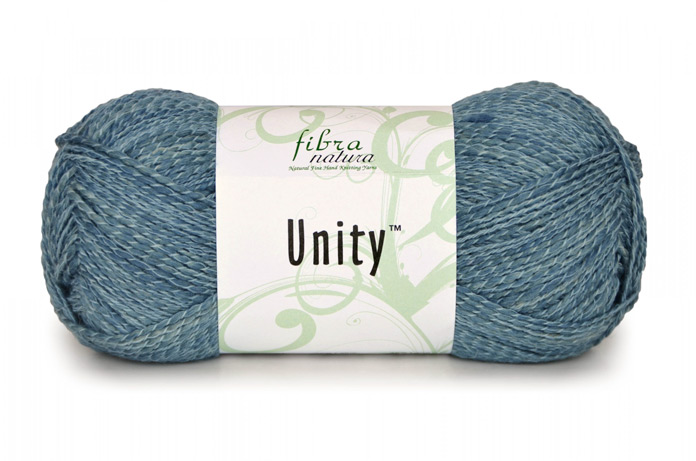This week, I’m excited to share my knitting experiences with Unity and Unity Beyond, an amazing blend of natural fibers by Fibra Natura.

Unity, pictured here in Blue Stone, is a subtle thick and thin yarn containing 4 different types of fiber: wool, linen, bamboo, and cotton.
Unity by Fibra Natura comes in 10 solid colors. Its painted version, Unity Beyond, comes in 6 complementary colorways. The palette is reminiscent of French Country decor with its muted, subtle colors that remind me of gardens and summer days.

The subtle bouclé texture and the moderate thick and thin twist of Unity result in textured knits that have a lot of body and visual depth.
In the case of Unity, the fiber content and the architecture of the yarn give it its unique character and strengths. Today we’ll look at the structure of the yarn and tomorrow we’ll look at its fiber content and what that does for knit fabric.

It took a few minutes to fray the end of Unity yarn because of its sturdy architecture.
Unraveling Unity yarn led me to an interesting discovery. There’s an inner core of loosely spun fibers, but around this core, there is a tiny strand of what looks like bamboo (there’s a definite sheen) that is spun with a Z-twist (spun counter-clockwise) around the core. You can see the glimmer of the bamboo in each segment of the bouclé, but it just looks like a strand that is parallel to the other fibers, but with the Z-twist, it is actually stabilizing those loose core fibers. Then there is another equally thin ply that is spun with a S-twist around the core and the bamboo strand, basically criss-crossing the bamboo strand to hold the core in place. This is also very loosely twisted and looks like one of the core’s strands when you aren’t analyzing this up close. The final ply is about 3 times as thick as these first 2 thin plies and is tightly twisted with an S-twist, and then twisted around the core and the first 2 thin plies also with an S-twist. I would hazard a guess that the loose, fluffy fibers and this thicker binding ply are all a blend of wool, cotton, and linen as they are soft, yet matte.

Unity Beyond is the same yarn but has been painted in a series of multi-color hues.
Unity Beyond colors are added by one of two ways. In one process, the dyers pass the yarn through rollers where only the top rollers have the dye colors on them, and one half of the yarn is “painted” while the other side retains its natural white. In the other, the yarn goes under dye jets that spray only one half of the yarn. The effect in either case is similar to a marled yarn where one ply is a light color and the other is a contrasting color. The look of Unity Beyond when knit up reminds me of acid wash denim, only with in gradient stripes.

The painted effect of Unity Beyond creates gradual transitions between each color of this long-spaced self-striping yarn. The speckled appearance is reminiscent of Impressionist Art.
This is part 1 of 5 in this series.
Go to part 2: 36% wool, 28% cotton, 18% linen and 18% bamboo, what yarn is this?
[shareaholic app=”follow_buttons” id=”23784471″]
